
Thomas Dudley Harmon, nicknamed "Old 98", was an American football player, military pilot, actor, and sports broadcaster.

Leslie Horvath was an American football quarterback who won the Heisman Trophy while playing for the Ohio State Buckeyes in 1944. Horvath was the first Ohio State player to win the Heisman, an award given to the best college football player in the United States. The school retired his jersey number 22 in October 2000.

McKinley Senior High School is a public high school in Canton, Ohio, United States. It is the only secondary school in the Canton City School District and has two campuses: Downtown Campus and the main campus, which is known as McKinley Senior High School. Athletic teams compete as the Canton McKinley Bulldogs in the Ohio High School Athletic Association as a member of the Federal League.

Charles Wesley "Chic" Harley was an American football player and athlete, often credited with bringing Ohio State University's football program to national attention. Harley was Ohio State's first consensus first-team All-American selection and first three-time All-America selection. In 1951, he became a charter inductee in the College Football Hall of Fame.
Justin Zwick is a former American football quarterback who played college football for the Ohio State Buckeyes from 2002 to 2006. He played professionally with the Columbus Destroyers in the Arena Football League (AFL).

Robert Louis Vogel is an American former professional football player who was an offensive lineman for the Baltimore Colts of the National Football League (NFL) from 1963 to 1972. Vogel was a mainstay on the offensive line that protected quarterback Johnny Unitas, appearing in Super Bowl III and Super Bowl V with the Colts. During his career, Vogel was selected to five Pro Bowls and earned five All-Pro selections.

Thomas Laverne James, Jr. was an American football defensive back and punter who played for Ohio State University and the Cleveland Browns in the 1940s and 1950s. He was born in Canton, Ohio and attended Massillon Washington High School, where he played as a back on the football team under head coach Paul Brown. James was a key part of a Massillon team that went undefeated in 1940. After graduating, he followed Brown to Ohio State and played there as a halfback. Ohio State won its first national championship in 1942 when James was on the team.
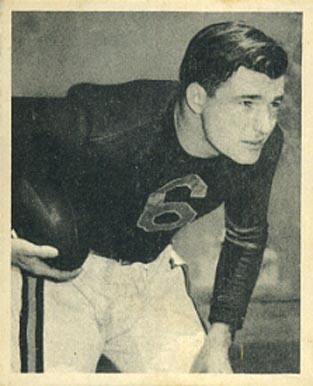
Donald John Kindt, Sr. was an American defensive back and halfback who played nine seasons from 1947 to 1955 for the Chicago Bears in the National Football League (NFL). Kindt played college football for the University of Wisconsin Badgers primarily as a halfback from 1943 to 1946, missing the 1944 and half of the 1945 season because of World War II. He was the starting halfback for the Badgers for most of his college career.
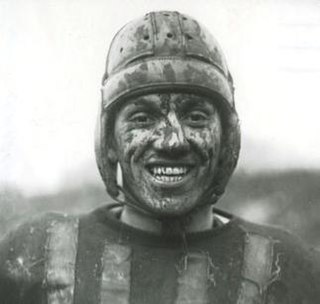
Gaylord Roscoe "Pete" Stinchcomb was an American football player. He played quarterback and halfback at Ohio State University where he was selected as a consensus All-American in 1920. He later played professional football as a back for the Chicago Bears (1921–1922), Columbus Tigers (1923), Cleveland Indians (1923), and Louisville Colonels (1926). He was inducted into the College Football Hall of Fame in 1973.
The 1940 Michigan Wolverines football team represented the University of Michigan in the 1940 Big Ten Conference football season. Under third-year head coach Fritz Crisler, Michigan compiled a 7–1 record and finished the season ranked No. 3 in the final AP Poll. The team outscored opponents 196 to 34. The team's sole setback was a 7–6 loss on the road against a Minnesota team that finished the season No. 1 in the final AP Poll.
Jack Graf was a two-sport athlete at Ohio State University. In football he was named Big Ten MVP in 1941 and in basketball he served as team captain in 1942.
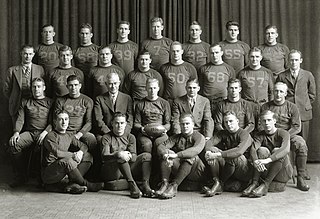
The 1930 Michigan Wolverines football team represented the University of Michigan in the 1930 college football season. The head coach was former Michigan star, 31-year-old Harry Kipke, in his second year in the position.
The 1941 Michigan Wolverines football team represented the University of Michigan in the 1941 Big Ten Conference football season. Under fourth-year head coach Fritz Crisler, Michigan compiled a record of 6–1–1, outscored opponents 147 to 41 and was ranked No. 5 in the final AP Poll. The team played three ranked opponents, defeating No. 5 Northwestern (14–7), playing to a tie with No. 14 Ohio State (20–20), and losing by a 7–0 score to the 1941 Minnesota team that won the 1941 national championship. With a strong, veteran line, the Wolverines also shut out four of their eight opponents: Pittsburgh (40–0); Columbia (28–0); Illinois (20–0); and Iowa (6–0).
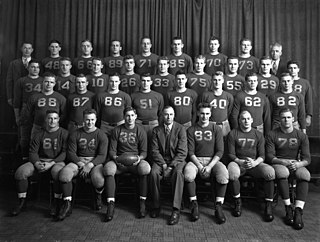
The 1943 Michigan Wolverines football team represented the University of Michigan in the 1943 Big Ten Conference football season. Fritz Crisler, in his sixth year as head coach, led the team to an 8–1 record and a tie with Purdue for the Western Conference championship. The team was ranked No. 3 in the final AP Poll behind Notre Dame and the Iowa Pre-Flight School. Michigan outscored its opponents 302 to 73 in nine games. The team's total of 302 points was the highest point total for a Michigan team since the 1917 team scored 304 points in 10 games. Defensively, the team held every opponent, except Notre Dame, to seven or fewer points.

The 1946 Michigan Wolverines football team represented the University of Michigan in the 1946 Big Nine Conference football season. In their ninth year under head coach was Fritz Crisler, the Wolverines compiled a 6–2–1 record, outscored opponents 233 to 73, and finished the season in second place in the Big Nine Conference and ranked No. 6 in the final 1946 AP poll. The team's two losses came against an undefeated Army team that was ranked No. 2 in the final AP poll and against an Illinois team that won the Big Nine championship and was ranked No. 5 in the final AP poll. Michigan won its last four games by a combined score of 162 to 19, starting a 25-game winning streak that continued for nearly three years until October 8, 1949. In the final game of the 1946 season, Michigan defeated Ohio State, 58–6, the Buckeyes' worst defeat since joining the conference in 1913.
The 1944 Michigan Wolverines football team represented the University of Michigan in the 1944 Big Ten Conference football season. Under seventh-year head coach Fritz Crisler, Michigan compiled a record of 8–2, outscored opponents 204 to 91, finished in second place in the Big Ten Conference, and was ranked #8 in the final AP Poll. The team opened the season with a victory over an Iowa-Pre-Flight team that won all of its remaining games and ended the season ranked #6 in the final AP Poll. The Wolverines then shut out four opponents: Marquette (14-0); Northwestern (27-0); Illinois (14-0); and Wisconsin (14-0). The team's two losses came against Indiana and an undefeated Ohio State team that was ranked #2 in the final AP Poll.
The 1939 Michigan Wolverines football team represented the University of Michigan in the 1939 Big Ten Conference football season. Under second-year head coach Fritz Crisler, Michigan compiled a 6–2 record and outscored opponents 219 to 94. The team was ranked No. 2 in the AP Poll after winning its first four games by a combined score of 165 to 27, but lost its fifth and sixth games to Illinois and Minnesota. After winning its final two games, the Wolverines finished the season ranked No. 20 in the final AP Poll. In the post-season rankings by Frank Dickinson, the University of Illinois professor who developed the Dickinson System, Michigan ranked seventh in the country.
The 1938 Michigan Wolverines football team represented the University of Michigan in the 1938 Big Ten Conference football season. After the firing of Harry Kipke in December 1937, Fritz Crisler took over as Michigan's head coach in February 1938. In the first year of the Crisler era, the Wolverines compiled a 6–1–1 record and outscored opponents 131 to 40, allowing an average of only five points per game. The team's only setbacks were a 7-6 loss to Minnesota and a scoreless tie with Northwestern. The Wolverines finished the season ranked No. 16 in the final AP Poll. In the post-season rankings compiled by Frank Dickinson, the University of Illinois professor who developed the Dickinson System, Michigan ranked sixth in the country.
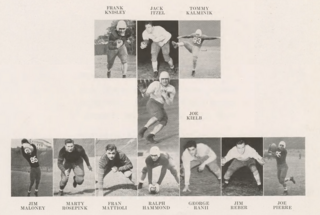
The 1943 Pittsburgh Panthers football team represented the University of Pittsburgh in the 1943 college football season. The team compiled a 3–5 record under new head coach Clark Shaughnessy.
The 1944 Big Ten Conference football season was the 49th season of college football played by the member schools of the Big Ten Conference and was a part of the 1944 college football season.











